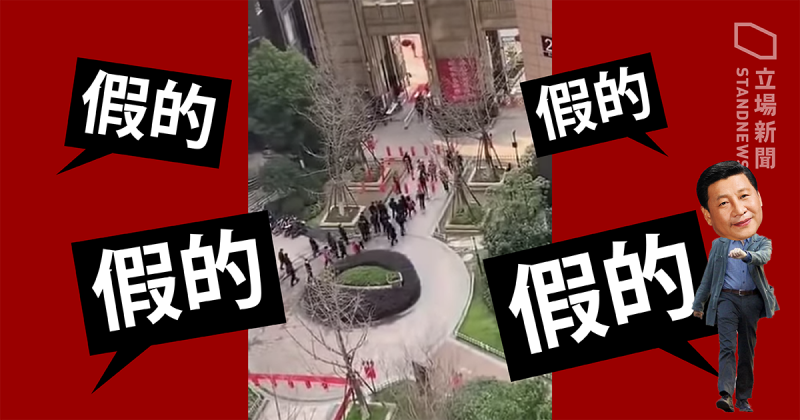
A spoof image from the Stand News [1] of Chinese vice premier Sun Chunlan's visit to a residential district in Wuhan during which residents yelled out from their apartment windows: “Fake, it is all fake,” “It is all formalistic [performance].”
When the unknown SARS-like virus was identified in Wuhan on December 8, 2019, Chinese authorities suppressed coverage of it, claiming that the disease provoked by it was non-transmissible among humans, and flagging any contradictory claims as fake news. The lunar new year celebrations, which usually involve big family gatherings, took place as scheduled until January 20 [2], when Dr Zhong Nanshan [3], a prominent Chinese pulmonologist who discovered the first SARS coronavirus in 2003, spoke on China Central Television confirming that 14 medical workers in Wuhan were infected with the new virus.
Three days later, on January 23, Beijing announced [4] the shutdown of the city of Wuhan. But it was too late, as more than five million Wuhan residents had left the city since early January.
Hong Kong was among the first regions outside mainland China to be affected by the outbreak. The public became frustrated with the government’s [5]hesitation to block mainland visitors from travelling to Hong Kong. Still, the city's experience with the 2003 SARS outbreak, along with people's strict adherence to social distancing and semi-quarantine measures, have managed to successfully keep the epidemic under control [6] throughout 2020.
As Wuhan was under complete lockdown and the majority of state-affiliated media outlets only reported on positive news about governments’ effort to control the spread of the epidemic, citizen reporters such as Chen Qiushi [7], diary writers such as feminist activists Guo Jing and Ai Xiaoming [8] became the main sources for people to learn about the grassroots situation within the city.
Chinese social media was flooded with critical voices. A number of investigative reports [9] from finance news outlet Caixin revealed that authorities had suppressed coverage of the outbreak, arrested whistleblowers, banned the disclosure of COVID-19 genome sequencing for at least two weeks, and censored related online discussions for more than one month.
The cover-up misled the World Health Organization [10], which delayed recommending countries worldwide ban travel from China—something that could have prevented [11] the global spread of the outbreak.
The news about the death, by COVID-19, of Dr Li Wenliang, a frontline doctor who had been arrested by the Wuhan police and forced to sign a statement of regret for “spreading rumors” about the virus’ human transmissibility, set Chinese public opinion on fire [12]. Many criticized the political system that suppressed freedom of the press and speech [13]. Some even described the public awakening to the catastrophe as “China’s Chernobyl moment [14].”
But the upheaval was short-lived. All critical opinions questioning the authority of the Chinese Communist Party were deleted from social media [15]. A massive number of social media groups and user accounts were removed [16]. Citizen journalists, including Chen Qiushi [17], Fan Bing [18] and Zhang Zhan [19] were arrested. Diary writers such as prominent Chinese novelist Fang Fang [20] were attacked by online patriots.
At the same time, positive energy [21] was injected into social media, which was quickly taken over by stories about the failure of other countries [22] to control the pandemic. State-owned news agency Xinhua went as far as to call for the world to thank China [23] for its achievements in the fight against the novel coronavirus. Disinformation that claimed the new virus originated in countries other than China, such as the USA and Italy, also went viral on Chinese social media, in particular after the spokesperson of the Chinese Foreign Ministry endorsed the conspiracy theory [24].
Since then, successful stories about China’s medical assistance to other countries [25], economic growth and leading development of COVID-19 vaccines took over both mainstream and social media around the world. But some of those stories are false, including the distortion of a WHO scientist's remarks [26] on the development of Chinese vaccines.
In Hong Kong, pro-Beijing politicians have been advocating for the implementation of a mandatory health code system [27] similar to the mainland Chinese system which restricts individual access to public services according to a three-colored code. So far, a voluntary health code system [28] has been implemented for the purpose of recording individual movement in public spaces, but it has not been used to restrict individual movement.
More recently, Chinese President Xi Jinping defended the adaptation of the Chinese health code system to restrict and monitor global travel [29], and many are worried that the normalization of epidemic surveillance measures will undermine human rights [30] and eventually liberal and democratic culture.
It is worth noting that the most successful anti-pandemic story has come from Taiwan—a de-facto separate state [31] from China after the civil war when the Kuomingtang was defeated by the Chinese Communist Party in the Chinese Civil War (1945-1950). While there are about 1-2 million Taiwanese living in China for business, work, and education purposes, the country had started taking preventive border control measures and alerted the public about the outbreak since early January, as its government had spotted the “rumors” circulating in China about the outbreak in December. After a small outbreak in spring, without tracking and restricting citizens’ health condition and movement, the country had zero local transmission cases for more than 250 days [32] until a case was spotted on December 22.
Thus far, the country only has 749 recorded cases, and the majority have been imported cases. Yet, the WHO has continued to refuse to integrate Taiwan [33] in its global fight against and prevention of the epidemic due to pressure from Beijing.
The China model [34] of public health emergency response has successfully contained the outbreak, yet the massive tracking and restriction of people's movement has human rights consequences. Hence, many see the Taiwan model a more valuable reference to epidemic control [35].